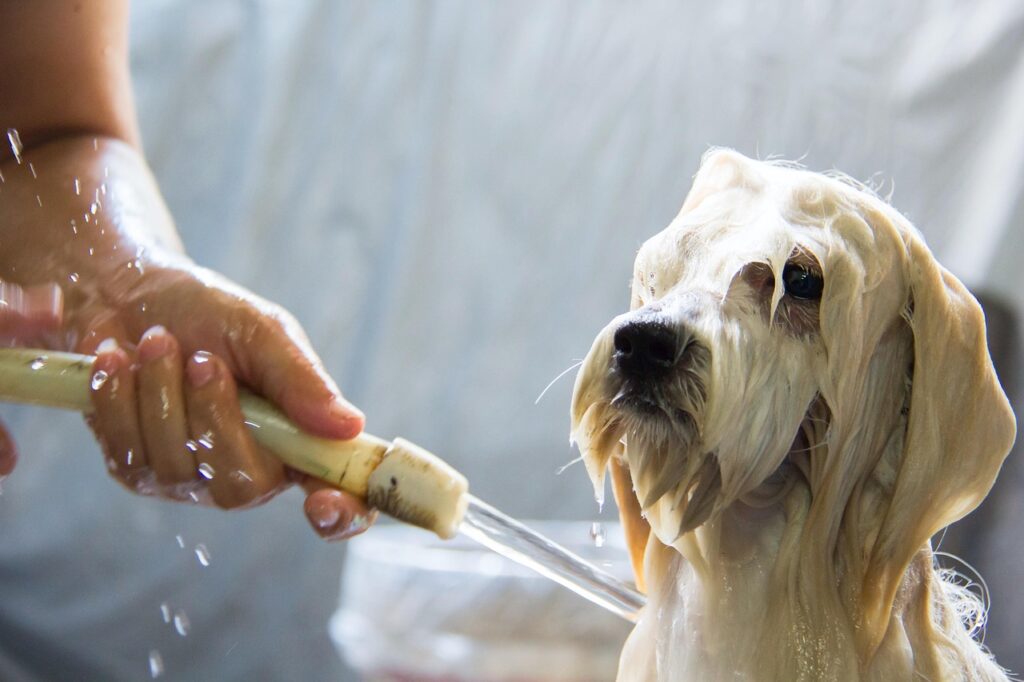Dog owners often make well-meaning choices that can actually harm their pets’ health and wellbeing. Many common practices seem helpful but can create problems that veterinarians see repeatedly in their clinics.
Understanding these mistakes helps dog owners provide better care and avoid unnecessary health issues for their pets. From feeding habits and grooming routines to medical decisions and training methods, small changes in daily care can make a big difference in a dog’s quality of life.
1) Overfeeding leading to obesity
Many dog owners show love through food. They give extra treats and large meals thinking it makes their pets happy.
This kindness can harm dogs. Overfeeding creates a calorie imbalance when dogs eat more than they burn through activity.
Weight gain happens quickly with too much food. About 59% of dogs are overweight or obese according to recent studies.
Obesity strains joints and internal organs. It leads to serious health problems like diabetes and arthritis. Vets recommend measuring meals carefully. Treats should make up less than 10% of daily calories to keep dogs healthy.
2) Frequent unnecessary baths

Many dog owners think frequent baths keep their pets healthier. This common mistake actually harms dogs more than it helps.
Dogs have natural oils in their skin and coat. These oils protect them from irritation and keep their fur healthy. Too much bathing strips away these important oils.
Most dogs only need baths every 2 to 4 weeks. Some dogs with specific skin conditions might need different schedules based on their vet’s advice.
Signs a dog needs a bath include strong odors, visible dirt, greasy fur, or excessive scratching. Clean dogs without these signs don’t need washing yet. Over-bathing can cause dry skin, irritation, and coat problems.
3) Letting dogs off-leash in waiting rooms
Many pet owners let their dogs roam free in vet waiting rooms. This creates safety risks for all animals present.
Even well-behaved dogs can become unpredictable in stressful environments. They may run toward other pets or disappear into restricted areas.
Other dogs in the waiting room might be sick, injured, or aggressive. A friendly approach from an unleashed dog could trigger a dangerous reaction.
Some pets prefer to be left alone when they feel unwell. An unleashed dog disrupts their space and increases their stress levels.
Keeping dogs on shortened leashes close to their owners prevents conflicts and maintains order in the waiting area.
4) Ignoring signs of pain or discomfort

Dogs hide pain as a survival instinct. They don’t cry or complain when something hurts. Many owners think their dog is fine because they still eat or play. But dogs often mask discomfort well.
Subtle signs include moving slower, sleeping more, or avoiding stairs. Changes in appetite or behavior can also signal pain.
Vets see owners who wait too long to seek help. They attribute limping or stiffness to normal aging.
Pain that goes untreated gets worse over time. Early treatment prevents bigger problems later. Trust your gut if something seems off. Vets can spot pain signs that owners miss.
5) Not informing staff about aggressive behavior
Many dog owners fail to warn vet staff about their pet’s aggressive tendencies. This creates dangerous situations for everyone involved.
Veterinary professionals need to know if a dog bites, snaps, or shows fear-based aggression. This information helps them prepare proper safety measures.
Staff can use muzzles, sedation, or extra handlers when needed. They can also adjust their approach to reduce stress for the animal.
Some owners worry their dog will receive poor treatment if they mention aggression. However, vets understand that fear and pain often cause these behaviors.
Honest communication protects both the medical team and the dog from injury.
6) Using unapproved medications without vet guidance
Many dog owners give their pets human medicines or buy drugs online without checking with a vet first. This can be very dangerous for dogs.
The FDA warns about unapproved animal drugs sold online. These medicines may not work properly or could harm your dog. Human medicines can be toxic to dogs. What helps people might hurt your pet badly.
Even natural pain relief methods should be discussed with a vet. Dogs need different treatments than humans do.
Always buy pet medicines from trusted sources. Your vet knows which drugs are safe and effective for your specific dog.
7) Forgetting dental care routines
Most dog owners skip dental care for their pets. Less than 10% of dog owners brush their dog’s teeth regularly.
Poor dental health connects to serious problems. It can lead to liver disease, kidney disease, and heart issues.
Dogs need regular teeth brushing just like humans. Dental treats and toys help but don’t replace brushing. Vets see the same dental problems over and over. Tartar buildup and gum disease are very common.
Starting dental care early makes it easier. Dogs get used to the routine when they’re young. Human Food is too salty and fatty for dogs. It can also harm their teeth and gums.
8) Neglecting proper parasite prevention
Many dog owners skip parasite prevention or only use it during warm months. This is a costly mistake that puts dogs at serious risk.
Parasites like heartworms, fleas, ticks, and intestinal worms can attack dogs year-round. A single mosquito bite can infect a dog with heartworms that grow into foot-long worms in the heart and lungs.
Monthly prevention medications are simple and affordable. They protect against multiple parasites at once and prevent serious health problems later.
Skipping regular parasite prevention often leads to expensive treatments and painful conditions for dogs.
9) Skipping regular vet visits
Many dog owners only visit the vet when their pet is sick. This approach misses important chances to catch health problems early.
Dogs should get annual wellness exams even when they seem healthy. These visits help vets spot issues before they become serious.
Regular check-ups also give owners access to important advice about diet and care. Vets can update vaccines and discuss any changes in behavior.
Skipping these visits can lead to undiagnosed health problems. Early detection often means easier and cheaper treatment options for dogs.
10) Failing to socialize dogs properly
Many dog owners make mistakes when socializing their pets. Some start too late or rush the process with new dogs and people.
Proper socialization helps dogs become confident and well-adjusted. Dogs that miss early socialization often show fear, anxiety, or aggressive behavior later.
The best time to socialize puppies is before 8 months old. However, owners can still help older dogs learn social skills with patience.
Common mistakes include overwhelming dogs with too many new experiences at once. Dogs should meet others of similar size and calm temperament first.
11) Over-relying on treats for training
Many dog owners use treats for every training session. This creates a problem where dogs only listen when food is present.
Vets see dogs that won’t obey basic commands without treats. The dogs become dependent on food rewards instead of learning proper behavior.
Treats work well for teaching new skills. But owners should slowly reduce treat use as dogs learn commands.
Dogs need to respond to praise and verbal cues too. Using only treats makes training harder in the long run. The goal is teaching dogs to behave well without constant food rewards.






